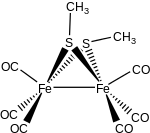Methylthioirontricarbonyl dimer
 | |
| Names | |
|---|---|
| Other names
Methanethiolatoirontricarbonyl dimer | |
| Identifiers | |
| 14878-96-7 | |
| ECHA InfoCard | 100.035.396 |
| Properties | |
| C8H6Fe2O6S2 | |
| Molar mass | 373.94 g/mol |
| Appearance | red crystals |
| Melting point | 65 °C (149 °F; 338 K) (isomer A), 102 °C (isomer B) |
| Except where otherwise noted, data are given for materials in their standard state (at 25 °C [77 °F], 100 kPa). | |
| Infobox references | |
Methylthioirontricarbonyl dimer, also known as methanethiolatoirontricarbonyl dimer, is an organometallic compound with the formula Fe2(SCH3)2(CO)6. It is a red volatile solid that is classified as a transition metal thiolate complex. It exists as air-stable red crystals with two isomers, where the methyl groups are either anti (isomer A) or syn (isomer B) with respect to each other.[1]
Synthesis
It was first synthesized 1940[2] with the discovery of isomers in 1962.[3] Synthesis involves treating triiron dodecacarbonyl with dimethyl disulfide:
- 2 Fe3(CO)12 + 3 (CH3)2S2 → 3 [Fe(CO)3SCH3]2 + 6 CO
It can be purified by recrystallization or by sublimation. The isomers can be separated by chromatography using pentane in an alumina column.
Structure
The methylthioirontricarbonyl dimer consists of two iron atoms with distorted square pyramidal coordination geometry disregarding any potential Fe-Fe bond, and distorted octahedral including an Fe-Fe bond. Each iron has three terminal carbon monoxide ligands and two bridging methyl sulfide ligands. The Fe-Fe distance is 2.537 Å with an average Fe-S bond length of 2.259 Å. The average Fe-S-Fe bond angle is relatively small at 68.33°. Out of the four possible isomers, those being equatorial-equatorial, axial-equatorial, equatorial-axial, and axial-axial methyl conformations, only two are seen. This is due to the axial-axial isomer being unfavorable due to steric hindrance. The axial-equatorial and equatorial-axial are identical since the structurally related compound [Fe(CO)3S]2 has idealized C2v symmetry. Isomer B has idealized C2v symmetry while isomer A has idealized Cs symmetry.[4]
References
- ↑ King, R. B. "Organometallic Synthesis, Volume 1: Transition-metal compounds" (1965) Academic Press. ISBN 0124080502
- ↑ Hieber, W., Scharfenberg, C. "Einwirkung organischer Schwefelverbindungn auf die Carbonyle des Eisens" Chem. Ber. 1949, vol. 73, 1012. doi:10.1002/cber.19400730914
- ↑ King, R. B. "Organosulfur Derivatives of Metal Carbonyls. I. The Isolation of Two Isomeric Products in the Reaction of Triiron Dodecacarbonyl with Dimethyl Disulfide" J. Am. Chem. Soc. 1962, vol. 84, 2460. doi:10.1021/ja00871a045
- ↑ Dahl, L. F., Wei, C. H. "Structure and Nature of Bonding of [C2H5SFe(CO)3]2" Inorg Chem. 1963, vol. 2, p. 328. doi:10.1021/ic50006a022
